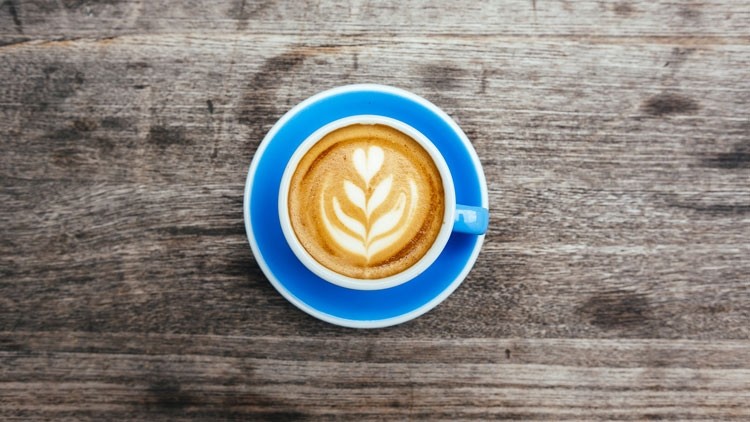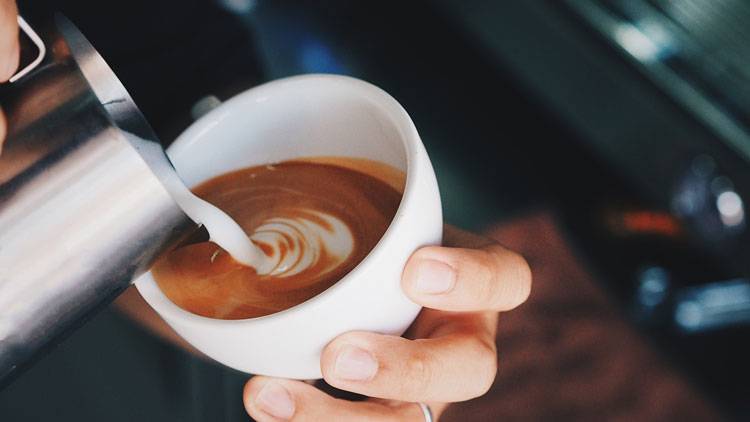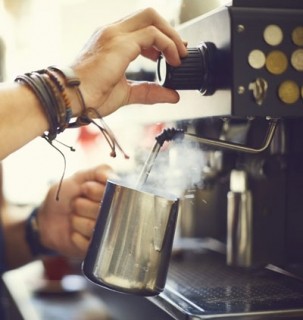Why restaurants need to up their tea and coffee game

Do you take your coffee and tea selection as seriously as you do your wine offer? Do you have a range of hot drinks that makes your establishment stand out from the crowd. Can your restaurant compete on quality with the artisan coffee house round the corner? If the answer to any of these questions is no, it’s time to wake up and smell the coffee.
The days where restaurants could serve an average cup of Joe at the end of the meal are long gone. But even serving a high quality coffee is no longer enough these days. Consumers have started to experiment with their coffees, says Barry Kither, sales and marketing director at Lavazza UK.
“An example of this is the trend of ‘fizzy coffee’, which became a trend that originated from the Italian ritual of serving the classic espresso with a shot of sparkling water on the side,” he says. “In order to experiment with this, baristas and bartenders have recently started trialling cold brews and tonic water to create unique serves. Due to its gentle brewing method (coffee grounds are steeped in room temperature water for 24 hours), it is sweeter and less acidic than espresso with pronounced flavours. As a result, it very much lends itself to mixology.”
One big coffee trend has been nitro coffee. Much has been said about nitro coffee over the past few years, but 2018 is the year it has finally gone mainstream. This is thanks, in part, to technology that made it easier for the coffee chains, as well as restaurants and bars, to serve the drink.
Cold brewed coffee infused with nitrogen has become popular with places because of the theatre it adds to a drinks menu – the settling effect caused by the nitrogen as the drink is poured gives it a visual USP – and with customers for its smooth and creamy taste and mouthfeel, which is comparable to that of stout. Nestlé Professional recently entered the nitro coffee game with its Nescafe Azera Nitro Americano and Nitro Latte drinks, both of which can be dispensed from its branded countertop tank.
Served cold, the drink opens up coffee to new occasions – beyond being an after dinner drink in restaurants, and can be used in cocktails, such as a nitro espresso martini – and new drinkers.
“Non-alcoholic beverage options are increasingly important for the UK and Irish consumer, especially younger generations,” says Nestlé Professional business executive officer George Vezza. “Nescafé Azera Nitro means Nestlé Professional can help our partners across all the catering and hospitality sectors make the most of these changes with our novel, attractive and great tasting chilled coffee drink.”
For restaurants that don’t have space for a machine but still want a slice of the nitro coffee action there is a solution in the form of the NitroPress, which its maker Hatfields says offers a more flexible method of serving it. “Draught coffee systems are fantastic in busy stores with high demand. After initial setup, they are fast and easy to operate – allowing retailers to reduce time from order through to customer serving. However, unless there is demand for high volumes, they can be inefficient,” says Hatfields.
The handheld dispenser uses specially developed nitrogen gas cartridges. The unit is filled with coffee and pressurised with flow controlled portions served through a special nozzle designed to create a unique cascading effect and ultra-smooth foam head. “As part of our vision to make nitro coffee accessible to all, we took the original concept and optimised it – stripping out complexities to keep it simple,” says managing director Jack Hatfield. “The goal was to place a NitroPress in front of anyone and for them to intuitively work out how to use it.”
Give it some beans
As the market for coffee becomes more sophisticated and as consumer understanding of coffee beans and their origins grows, suppliers are looking to introduce drinkers to new flavours and regions.
UCC Coffee UK & Ireland, for example, has launched a ThreeSixty° coffee range for restaurants that uses beans sourced from areas that aren’t front of mind when thinking about coffee. The four-strong range of single origin coffee includes one from Mexico and another from Myanmar, designed to enable drinkers to try coffees from less-known coffee growing countries.
The Mexican coffee is described as having smooth milk chocolate and mandarin flavours while the Myanmar coffee delivers delicious soft caramel and sundried fruit flavours, says UCC, thanks to the cooler climate of this up-and-coming coffee growing country.
“On our adventures to source the new coffees we’ve found incredible flavours from all over the world. Each of the blends is as distinct as it is delicious, with its own unique story and profile,” says marketing manager Nicole Hartnell. “The single origin range celebrates just how complex and colourful coffee can be, with a varied mix of flavours to appeal to all consumer tastes.”
In addition, the company has created three new blends – Elevation, Rainforest and Four Corners – which it says will help operators improve their coffee offer.
Lavazza’s Kither also says that consumers are looking for more of a story when it comes to their coffee. “For today’s consumers, it comes down to more than good taste and quality – guests want a story behind their brands which they can relate to and be proud to support.”
He cites Lavazza’s Rainforest Alliance-certified ¡Tierra range as one such example. ¡Tierra aims to improve the social and environmental conditions and production techniques of a number of coffee-growing communities in Colombia, India, Peru, Vietnam, Tanzania, Honduras and Ethiopia.
Getting kitted out
As well as sourcing the right coffee for your business, using the right kit is essential to ensure your coffee serve is as good as it can be. “It is important for businesses to match the rise in consumer demand for high quality coffee by using the correct machinery and tech as well as catering to the needs of consumers and adapting to new trends. With the right kind of technology, you can ensure that the quality of your coffee serves is at its best,” says Kither.
Lavazza’s solution to providing barista-quality coffee is capsules, which it says is the fastest-growing part of its business. “A capsule-based solution allows restaurants to provide their customers with a variety of serves at consistent quality, cost-effectively,” adds Kither.
Its Lavazza Blue systems for restaurants use single capsules that contains a 7g to 8g dose of coffee, the same dose baristas use for each espresso they serve to their customers. They also have a temperature-controlled steam arm that allows the milk jug to be left still on the platform, with no extra manoeuvre from the barista, creating consistent foam that doesn’t burn or overheat the milk (see Getting into a froth). The temperature-controlled steam arm is a key element for non-specialists in the coffee sector as the milk foaming element is a tricky skill to master, says the company.
Fellow Italian coffee company La Cimbali has recently extended its range of professional coffee machines with the launch of the S20, dubbed the little sister to its S30 Perfect Touch. Designed to deliver up to 200 cups of coffee and milk based beverages a day, the S20 has a compact size and small footprint for use where space is at a premium and lower drink volumes are anticipated. When configured in ‘power station’ mode, it can simultaneously deliver milk based beverages from two adjacent machines, using only one fridge, thus optimising the work space even further.
The machine also uses the latest technology, including an integrated Wi-Fi system that allows remote control of all the machine’s settings (coffee boiler temperature, pump rate, recipe settings, colour of the lights), analysis of consumption data, such as coffee and milk quantities used, and preventive maintenance.
For operations that need to serve significantly more coffee, Douwe Egberts offers its Cafitesse Liquid Roast system. With Cafitesse, operators can serve up to 650 cups per hour and brew a 1.5 litre pot of coffee in under 23 seconds.
Coffee machine manufacturer Nuova Simonelli, meanwhile, has recently launched the Aurelia Wave, which it says is its most advanced espresso machine to date. The machine uses Simonelli’s patented Pulse-Jet technology, which the company says optimises flowrate and water pressure during dispensing, letting baristas explore different extraction profiles.
The machine also features T3 technology, which the company says brings complete temperature stability and control to expert baristas. The primary boiler, group boiler and group head can have three independent temperature settings, ensuring water temperature is perfectly controlled throughout the entire extraction. It also features Smart Water technology, which analyses water quality entering the machine.
“The Wave uses technology in ways never-before-seen in espresso machines. And what makes it so unique is how it houses this technology,” says Will Kenney, business unit manager at UCC Coffee UK & Ireland, which supplies the machines. “Despite being one of the most advanced machines ever manufactured, the machine has been designed to keep energy consumption at a minimum, lowering its environmental impact. And, its ergonomic design is tailored around the most important part of every coffee machine – the barista. Service is faster, smoother, safer and more efficient and, with the combined capabilities of Pulse-Jet and T3 technology, baristas can create coffees unlike any they’ve made before.”
Time for tea
Coffee continues to hog the limelight when it comes to hot beverages thanks to its third wave (or even fourth wave?) that has seen artisan coffee shops now regular sights on high streets across the country. And yet for restaurants and bars it is often tea, which is more subtle and has better food matching qualities, that is held in higher regard.
Thanks to the work from premium suppliers such as Jing, Taylors of Harrogate and Rare Tea Company in educating the industry about the different teas available and how they should be served, restaurants have improved markedly their tea offer over the past few years, leading to growth in the category.
Black tea with milk is still the most popular choice out of home, according to Taylors of Harrogate. However, the most recent Allegra report on tea found that almost 95% of operators who have refreshed their tea offering in some way have seen a restaurant sales uplift.
“New and innovative flavours is one of the main trends behind this growth so expanding your hot drinks menu to include a variety of green, fruit and herbal teas could help to increase consumer spend,” says Natalie Cross, out-of-home manager at Taylors of Harrogate.
“Choosing classic but more unusual teas, like Sri Lankan Ceylon, which can be served hot or cold, or tea connoisseurs’ favourite, white tea, will strike the right balance between adventurous and going too far with flavour combinations, which can put some consumers off.”
The widely held health benefits of tea should also encourage restaurants to widen their tea selection, according to tea brand Tetley. It says that restaurants should be looking to target new younger drinkers with different styles of tea.
“As many consumers become increasingly selective about their dietary choices, operators can promote the health benefits that these different blends offer and can tap into the current market trend and continue to drive sales, while attracting new advocates to the category,” says Marshall Kingston, Tetley senior brand manager.
“With consumers becoming ever more adventurous with their flavour preferences, they are also willing to spend more on drinks that they perceive to be of premium quality and healthy.”
Getting into a froth: how to master your milk
Just as drinkers have begun to realise that the majority of their G&T is in fact tonic, and to pay more attention to the mixer accordingly, so too should they understand about the importance of the white stuff in their cup of coffee.
The type of milk that is used, the way it is frothed (to make a cappuccino) or steamed or textured (for a latte) and at what temperature, all make a difference to how the coffee it is used in will turn out. While trained baristas will have all this covered, places that don’t use specialists, including many restaurants, need to be aware of just how important milk is in coffees.
The first thing restaurants should understand is the reason for heating up and frothing the milk. As well as helping to retain the temperature of the shot of espresso that it comes with, milk is frothed using a steam wand to change its taste profile and texture. Steaming heats the lactose in the milk, breaking it down into smaller, sweeter tasting sugars that gives the milk a sweeter taste (although if it is heated too much the sweetness will disappear as the sugars break down too much). Milk also contains proteins and these begin to unwind as heat is added to it, creating air bubbles as they do. These air bubbles become a foam or a microfoam, depending on how much it is steamed, and create a smooth drink.
According to coffee machine maker Capresso, the ideal temperature for steaming milk is around 70°C, with milk proteins starting to burn around 76°C.
The rise in non-dairy milks, such as those made from almonds or soy, adds another element of complexity to the coffee making process. Non-dairy alternatives don’t contains the same fats, protein and carbohydrates of milk and so can act very differently when heated. “Making coffee with plant- based dairy alternatives can cause frustration for baristas – they can split and destroy the much-loved, carefully crafted patterns on the top of drinks,” according to dairy company Arla. It says its Lactofree milk, however, shows no visual difference to standard fresh milk, ensuring a high-quality finish.
“It steams and foams consistently with no splitting and it creates the small tight microfoam required to achieve the intricate latte art that consumers love,” it says.
“Serving a high quality cup of lactose-free coffee has the potential to give a business an edge over its competitors, helping them to capture a small army of loyal coffee drinkers.”
Whatever milk you use, it is important that it is steamed when as cold as possible so that there is more time to control the steam before the milk reaches the optimum temperature.
The Insider
Jonathan Dixon, vice-president, Arla Pro UK
Why is using the right kind of milk so important for serving the best tea and coffee?
Milk proteins and milk fat have crucial importance when creating stable milk foams and attractive texture in coffee. With tea, this is less important and is more about preference on shelf life, organic products or lactose-free alternatives.
What are the best milks to use for the various types of tea and coffee and why?
The best milk is always going to be one which comes from a quality and consistent source. As with any natural product it can be affected through its lifecycle, so maintaining a reliable, controlled supply chain will guarantee a better product.
What about non-dairy milk – what types are the most suitable for baristas and why?
The right non-dairy milk is one that foams consistently, creating a small tight microfoam when steamed. Oat is becoming an increasingly popular choice for baristas because of this reason and the taste doesn’t overpower the flavour of the co fee. An alternative to those who are looking for a dairy milk without lactose is our Lactofree milk which has all the taste of milk just without the lactose.
What different dairy products does Arla have for restaurants?
Our standard fresh Arla milk is a perfect all-rounder, or if you’re looking for a longer shelf life we have Cravendale which lasts 21 days unopened and seven days once opened. Our Organic milk is produced by cows that graze outdoors on grass and clover where no artificial fertilisers or herbicides are used.
Alternatively, for a lactose-free option our Lactofree milk works great in coffee and comes in 20ml portions for serving on the side with a pot of tea.
In association with Arla Pro
@arlaprouk





















